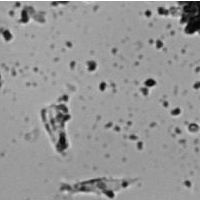Biocompatibility
Presentation:
The most common cause of failures of orthopaedic prostheses is aseptic loosening.It is due to the generation of wear particles in between the bearing surfaces during movements of the prosthesis. These debris are made of the different materials entering in the bearing couple: ultra-high molecular weight PolyEthylene (UHMWPE), chromiul-cobalt alloys, stainless steels, alumina or zirconia ceramics... Once released, the debrises can interact with the imune system, to provoke an inflammation that leads to aseptic loosening and revision of the prosthesis.
It is thus important to characterize the reactions of cells exposed to these debrises (produced in simulators or simulated by powders with the right granulometry). In this framework, I2B works mainly with osteoblasts and fibroblasts, but also increasingly with osteoclasts (in collaboration).
Typical publications:
O. Roualdes et al., In vitro and in vivo evaluation of an alumina-zirconia composite for arthroplasty applications, 2010, Biomaterials 31 (8) , pp. 2043-2054
Team: S. Balvay, D. Hartmann, J. Chevalier

phagocytosis of alumina particles by osteoclasts
Courtesy E. Decembre, P. Jurdic, IGFL

